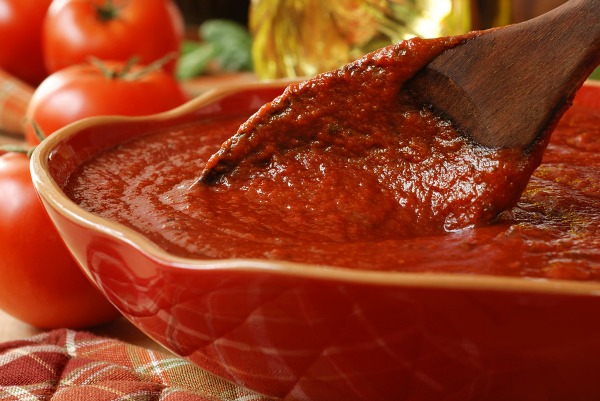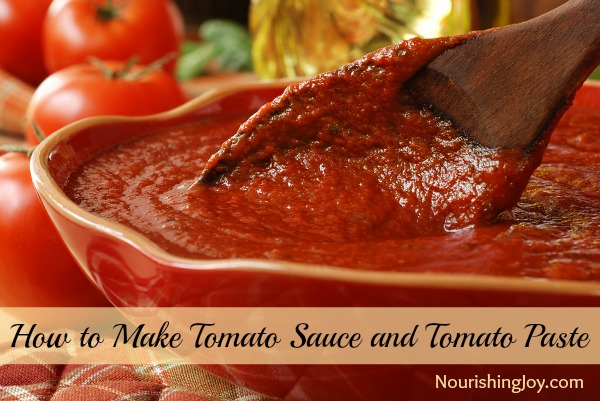How to Make Tomato Sauce (and Tomato Paste)
This post may contain affiliate links, including those from Amazon.com, which means we earn a small commission off your purchases. And here's the thing: We only mention services and products that we think are truly worth your attention, whether they're free, paid, or otherwise. This site relies on YOUR trust, so if we don't stand behind a product 110%, it's not mentioned. Period.
Tomatoes are one of my favorite summer crops. I anticipate them eagerly, waiting for them to be just right – not too big, not too small, not too hard, not too soft – and I revel in plucking them off the vine and serving them that day. I take more satisfaction, perhaps, in a successful crop of tomatoes than I do for many other goodies in our garden.
And that – perhaps – is with good reason. We enjoy tomatoes fresh, obviously, in a salad or sandwiched between fresh basil and mozzarella in the typical Caprese style. But more than that, we use them in the vast majority of our cooking all year round.
Big batches of tomato sauce and tomato paste come in very handy all year long. I like to make big batches of tomato sauce to freeze, which we then unthaw through the winter for tomato soup or any recipe that calls for tomato sauce or tomato paste.
Why Tomatoes Are So Nutritious
Tomatoes are one of those foods that actually increases in its nutrient-load when cooked, and tomatoes in their cooked form are powerful anti-oxidant and anti-cancer foods.
Like most (naturally) brightly-colored foods, tomatoes are high in lycopene, a carotenoid, which increases immune response, prevents heart disease, helps clear free radicals from the blood (can anyone say anti-aging?), and is essential for proper cell-to-cell communication. ((WHFoods.com – Carotenoids)) Since cancer is essentially long-term miscommunication between cells as they reproduce, this is the function that purportedly makes lycopene an anti-cancer substance. ((WHFoods.com – Tomatoes))
Tomatoes are also high in vitamins – Vitamins A, C, and K in this case – as well as a whole plethora of minerals ((WHFoods.com – Tomatoes)). It's important to eat them with a good quality oil or animal fat, as the carotenoids are fat-soluble and can only be absorbed and used by the body if there are sufficient sources of fat present. ((Colorado State University extention))
This is especially good news if you like cheese on your pizza or make your pasta sauce by sauteing the first ingredients in butter or oil before adding your tomato sauce. Yum!
So, without further ado – let's make tomato sauce!
Tomato Sauce
yields approximately 3 cups
12 lbs tomatoes (Roma-type are best, but any tomato will work just fine)
1 1/2 tsp. sea salt (optional)
Quarter tomatoes and place in large, heavy bottomed stockpot. You may blanch and peel the tomatoes first if you'd like, but it's much quicker and yields a deeper, richer sauce to leave the skins on. Add salt if desired – I prefer to skip the salt now to give greater variety later. I have found if I add the salt, but then add salt again when I make the pasta sauce or soup, it's overpowering.
Add a few tablespoons of water, cover, and heat over medium heat for 15-20 minutes until the tomatoes start to really release their juices. Remove the cover and decrease heat to medium-low. Simmer gently for 3-4 hours, stirring occasionally toward the end to make sure the tomatoes don't stick to the bottom of the pan.
Remove the pan from the heat when the sauce is the desired consistency. Process through a food mill to make it smooth. If you don't have a food mill, the mixture can be pressed through a fine sieve with the back of a spoon as well, but it will take much longer.
Freeze or can the sauce and compost the leftover skins.
Tomato Paste
same recipe as above, merely a longer cooking time
yields approximately 2 cups
For tomato paste, follow the recipe for Tomato Sauce, but add an additional 1 hour to the cook time.
Other Methods
I know there are some who prefer to roast their tomatoes in the oven and then puree them in a food processor, but whenever I use that technique, I inevitably burn the tomatoes at some point in the process, even at a low heat. The stove-top method, while a bit lengthy, has yielded consistently delicious results for me with each batch and – best of all – it makes your kitchen smell like summer.









I think you mean thaw, not unthaw. 😉
Actually, in standard American lexicon, “unthaw” and “thaw” have come to be used interchangeably, especially in informal speech and informal writing, even to the point that the Oxford English Dictionary lists it as acceptable use within North America.
I will, however, agree that “thaw” is clearer and in formal writing I would most certainly choose that over “unthaw.” However, it wasn’t an erroneous typo. Just chatty. 🙂
Made this tomato paste today using Roma and cherry tomatoes. I didn’t add anything, not even the salt, it’s very, very sweet but really tastey!